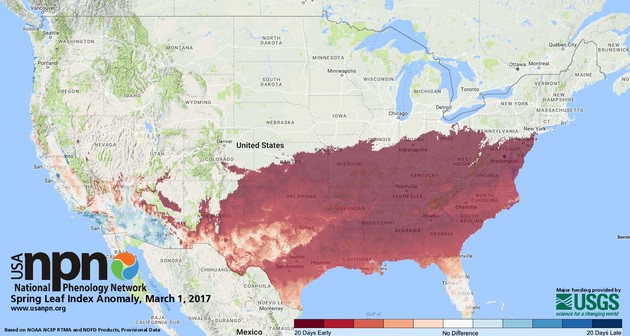
Uh oh! What’s that deep red color covering the U.S. from the Gulf Coast to Pittsburgh?
It’s the track of our too-early Spring.
This March 1 map from the National Phenology Network (usanpn.org) shows the status of leaf-out in the United States. It is darkest red is where leaf buds burst 20+ days ahead of schedule. It’s blue where spring is late.
Where is it blue? Click on the map to see a larger version and find the few places in Washington, California and Arizona where the leaves came out late.
We knew southwestern Pennsylvania was ahead of schedule. We just didn’t have the numbers.
Click here to read more about this map and the Spring Report.
p.s. NPN’s map is similar to Journey North‘s projects that track the arrival of rufous and ruby-throated hummingbirds and monarch butterflies. The plants are early this year but what about the birds and butterflies that rely on them? Uh oh! When they arrive “on time” they’ll be too late.
(map from the USA National Phenology Network, usanpn.org)
What is meant by:
Plants are early, this year. When the bird’s and butterflies who rely on them arrive,
“It will be too late.”
Why will it be too late? Will something else have used them up?
Thanks in advance.
Karen, everything is connected — the weather-temperatures / plants-blooming / bugs-hatching / birds arriving on migration. When the weather triggers the plants, it triggers the local bugs, too. However the birds that migrate out of North America use length-of-day cues in Central/South America to tell them when to come back north. When they get here in April/May, the plants and bugs have bloomed & peaked and subsided so there’s not as much to eat. Click here to read about the link between rose-breasted grosbeaks & oak flowers. (Rose-breasted grosbeaks leave North America. I mentioned bugs because some of them migrate, too. Dragonflies, for instance.)
Numerous trees budding in Duck Hollow this afternoon.
Last Thursday, March 2nd, a dead FEMALE Rubythroated Hummer was found and photographed in Tobyhanna PA – Monroe Co, along the Delaware River. Photo is on Fb “Hum. Migration Sighting” group. But I have more photos. Scott Weidensaul was hoping to preserve it as a documentation specimen, but I don’t think that happened. Still waiting to hear.
Point is: female RTHUs aren’t due in PA until mid-April!